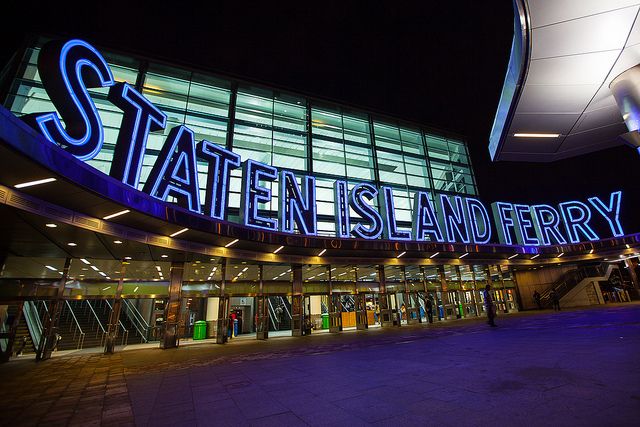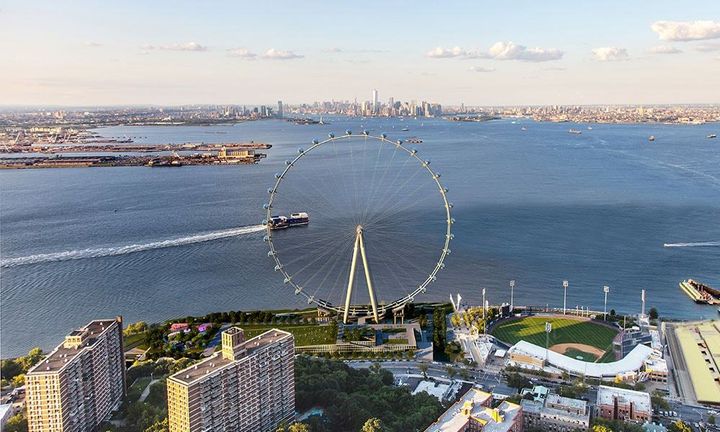
The Staten Island Ferry carries over 23 million passengers annually.
In 2015, The New York Times described the increasing attractiveness of Staten Island. “Big-city cool is popping up in a place not always noted for it,” they wrote. “A fresh crop of renters and buyers, unable to afford pricier precincts and unfazed by stereotypes about how the place can seem insular, bland or run-down, are setting sail for the island.”
Indeed, Staten Island could be nearing its golden era. Real estate investment and redevelopment efforts in the Bay Street Corridor and North Shore are gaining speed, with hopes of increasing economic vibrancy throughout the borough. Not to mention, supporters of the New York Wheel—a 630-foot-high Ferris wheel scheduled to be completed in 2018—hope to bring tourists and increased foot traffic to the island. These efforts could be the first sign that Staten Island is cultivating its own haven for the Creative Class—the thinkers, doers, techies, and artists known for changing communities.
With the hopes of better understanding who lives and works in Staten Island, my colleague Richard Florida, from the NYUSPS Schack Institute of Real Estate Urban Lab, and I explored the Creative Class structure of the borough. In previous weeks, I have summarized our findings about Manhattan and Brooklyn. A more complete version of this week’s Staten Island’s analysis is available here.
Despite its reputation as New York City’s “Forgotten Borough” (largely the product of its lack of rail connection to New York and New Jersey), Staten Island is home to nearly half a million residents. In fact, if the borough were a city, its size would rank ahead of Atlanta, Miami, and Minneapolis.
Nearly 30,000 workers in Staten Island—around 29 percent of the borough’s workforce—are members of the Creative Class. This makes Staten Island the smallest creative economy of all five boroughs in New York City, with Staten Island’s creative workforce accounting for a mere 2 percent of the city’s total. From 2011 to 2015, the borough’s creative workforce grew by 6 percent, and is expected to grow another 11 percent by 2025. Currently, there are more than 78,000 Creative Class members living in Staten Island, or about 4 in 10 residents. On average, Staten Island’s Creative Class earns $77,000 a year—21 percent less than creative workers in Manhattan, but 4 percent more than those in Brooklyn.

Despite the growth of Staten Island’s Creative Class, around 7 in 10 Staten Island workers belong to the service and working sectors. All together, Staten Island’s Working and Service Classes are double the size of its Creative Class, with over 73,000 workers. By comparison, around 128,000 service and blue-collar workers actually live in the borough. On average, service workers in Staten Inland earn $29,330 a year—62 percent less than the borough’s Creative Class and 33 percent less than its working sector.
A third of Staten Island’s Service Class—nearly 16,000 workers—is employed in Office and Administrative Support. Due to its location and harbor-related industries, Staten Island’s working sector includes a significant share of captains or pilots of water vessels (24 times the U.S. average), ship’s engineers (18 times), sailors (17 times), and ship loaders (10 times).
Staten Island’s Creative Clusters
What are the skills that distinguish Staten Island’s creatives from those in other boroughs? The chart below breaks down Staten Island’s creative clusters by employment, ten-year projection, annual salary, and location quotient.

Simply put, Staten Island’s creative workforce is tied to two sectors: health and community social services. With approximately 9,500 employees, Healthcare Practitioners is the largest creative cluster in the borough, exceeding the national average by 64 percent—the greatest margin of any creative cluster. In addition, Staten Island’s share of surgeons is four times the national average. (The dominance of this cluster is reflected in other classes as well. For example, Staten Island’s share of ambulance drivers is six times the U.S. average, while its share of home health aid workers is more than five times the national average.)
With just over 2,300 employees and an LQ of 1.37, Community and Social Service is one of two creative clusters in Staten Island that exceed the national average. However, this group of occupations has the lowest salary of all ten creative clusters—around $44,000 per year. Despite these low wages, Community and Social Service has seen the most significant growth among Staten Island’s creative occupations. From 2011 to 2015, the cluster grew by 14.1 percent and is expected to grow by 28.9 percent in the coming decade.

Construction for The New York Wheel, located in Staten Island’s St. George neighborhood, is slated to be completed in 2018.
Staten Island’s Education cluster contains just over 5,300 Creative Class employees and is expected to grow by 12.3 percent in the coming decade. Even with this growth, Education professionals in Staten Island receive some of the lowest average salaries of any Creative Class occupation—just over $50,000 a year.
Staten Island’s Management cluster consists of around 4,600 employees, compared to around 3,500 employees in its Business and Financial Operations cluster. Across all ten creative clusters in Staten Island, Management employees earn the highest annual salaries (about $121,000 per year), while those in Business and Financial Operations earn over $70,000 a year.
When it comes to the core clusters of creative economies—technology, science, arts, design, and architecture—Staten Island has no specialization and very small employment bases. With a mere 1,400 employees, Staten Island’s Computer and Mathematical cluster is nearly half the size of the national average (LQ 0.49), and has declined by 2.2 percent from 2011 to 2015. In addition, the borough’s Arts, Design, Entertainment, Sports, and Media cluster accounts for only 1,000 payroll employees, and is approximately 24 percent smaller than the U.S. average. It is worth noting, however, that an additional 1,000 self-employed creative workers in Staten Island have skills related to Art, Design, Entertainment, Sports, and Media.
Overall, it is no surprise that the majority of economic development efforts and investments in the borough are focused on improving its quality of place. Whether Staten Island can overcome its reputation as New York City’s “Forgotten Borough” will depend on its ability to attract new creative workers and retain its current members of the Creative Class.
